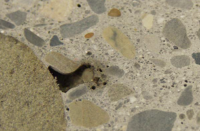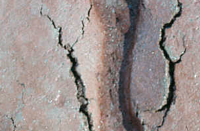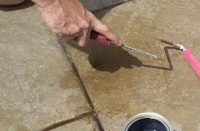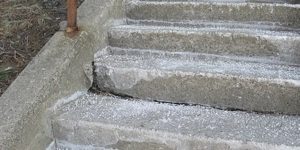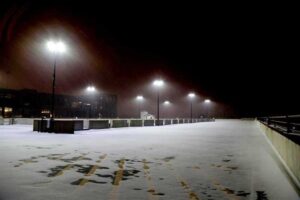
Winter and freeze-thaw have a way of exposing defects in concrete we normally would not see in warmer regions. These defects can be attributed to factors that include abuse of the water-to-cement ratio on the first day of the pour, improper finishing errors, a problem with the concrete materials, mix design, low or no air entrainment at time of pour, or even soft or reactive aggregates. They can be either installer-related or material-related.
Sometimes it is nearly impossible to figure out all of the factors that led to the surface problems without interviewing the installers who were present on the first day of the pour. But in any case, we must understand the materials we’re working with.
Think of concrete as a giant solid sponge continually taking moisture in and out throughout its life cycle. Understanding the importance of proper concrete mix design, finishing and curing techniques will minimize winter defects and provide your customer a lasting product for years to come.
What causes winter problems
It is widely believed that the de-icing chemicals we use on concrete during inclement weather are the major factor in winter problems. This is a misunderstanding. In reality, the chemicals themselves are not causing the problem. Rather, the issue is these chemicals’ effect on water molecule size as the temperatures drop into the freezing zone.
When water freezes, its volume naturally increases by up to 9 percent. When freezing is delayed with the application of a de-icer, the water volume will increase additionally one to four times beyond the point of where it expands when it freezes at 32 degrees.
Basically, the lower the temperature our water actually freezes at, the more it expands. This growth creates a situation where the concrete cannot handle the excessive hydraulic forces being created internally. Freeze-thaw defects arise as a result, normally in the spring in the form of surface defects such as spalling or pop-outs.
Let’s go through the gamut of de-icing chemicals, in terms of aggressiveness and delayed freezing action. We will start with urea. Urea is a natural chemical like salt. However, it is noncorrosive and only effective to about 23 degrees.
Potassium chloride formulations normally will work better and provide benefits to about 20 degrees.
Then we move to sodium chloride formulations like standard rock salt. You will see effectiveness down to about 12 to 15 degrees.
Now we move to calcium chloride and magnesium chloride chemicals, which are marketed as the modern pet-safe deicers. We all know them as the white, blue or green crystals. These are the upper end of de-icing chemicals and provide benefits in the range of zero to minus 25 degrees.
All these chemicals mentioned above work very similarly. The main difference between them is at what point the water (or now, water/brine solution) will actually freeze with their usage.
Prevention tips
Producing quality concrete with excellent freeze-thaw resistance and preventing surface problems for your customer actually begins on the day you plan to pour the concrete. This means taking into consideration the weather, concrete mix design and environmental conditions of the site, not to mention having a well-trained crew educated in proper finishing techniques.
Here are a few tips to help you:
- Ensure you have selected a concrete mix design that is capable of withstanding the environment where it’s placed. In the area where we live, northeastern Pennsylvania, we have some of the harshest freeze-thaw effects in the nation. It is recommended for outdoor use that we pour a 4,000-psi mix with air entrainment of approximately 5 percent, plus or minus 1 percent, and most importantly, we must keep our water-to-cement ratio in the area of 0.40 or less. The concrete spec for your area may be different due to your climate and season.
- Utilizing concrete from a reputable ready-mix supplier using sound aggregate is a must. I have seen plenty of defects after winter due to either soft or reactive aggregate being utilized in the mix. This can lead to scaling or pop-outs.
- Avoid long transit times for the ready-mix and excessive mixing at high speed. Both could deplete air entrainment in your concrete, leading to durability issues.
- Proper placement and finishing techniques must be utilized throughout the installation process to ensure quality concrete. If you are pouring in winter months you should never pour on frozen ground. Under- or overworking the concrete and premature finishing can cause durability issues with the surface. Extra water added at a job site can also lead to surface problems and poor finish quality, especially if the mix design you’re using has not achieved the desired water-to-cement ratio.
- Curing must be taken into consideration for long-term success. If you’re pouring in winter months your concrete must gain at least 500-psi strength before it is exposed to freezing temperatures. If the surface is exposed to frost or freezing temperatures prematurely on the original day of the pour, the long-term durability of the surface will very likely suffer. It is imperative to select a day during which you have acceptable weather conditions and above-freezing temperatures throughout the pouring and the initial set of the curing process.
Hopefully this information will give you some insight as to de-icers and the main reason you see damage as a result of their use. Understanding concrete and how to produce a quality installation will provide your customer with trouble-free years of use.
One more thing: No matter what time of year the concrete has been poured, it should never be exposed to de-icing chemicals during the first winter. Your concrete will be much more durable in years to come. Even if the concrete was poured in April and allowed to cure all summer, avoid the de-icer chemicals the first year. When the concrete has gone through a full season or two of freeze-thaw cycling it will become a much more durable product in the long run.
Please educate your customer to this fact. It will spare you many callbacks and displeased customers. I have seen many homeowners destroy first-year concrete due to not being educated about keeping deicers off the surface during the first winter season.
